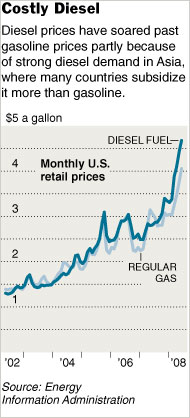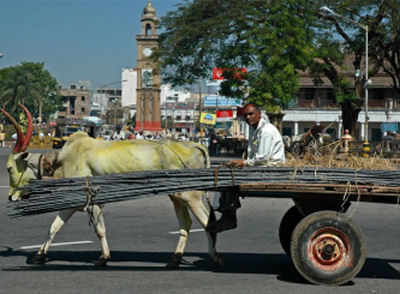Why Fuel Prices Will Come Down
The 42% rise in fuel prices during the last six months did not occur because
Chinese car sales are up 18% this year. Rather there has been a confluence of factors
that have spiked fuel prices almost straight up, and many analysts feel they can
be expected to drop back into the low $3 range next spring, if not sooner. Oil traders
say that one of the reasons oil prices shot skyward this spring is that China began
bulking up on oil to make sure they had plenty for this summer's Olympic Games.
We have been through this high fuel price hysteria in the U.S. before, and guess
what has always happened in the past? Just as Congress is beginning to think about
thinking about an energy policy, fuel prices come down just in time for GM bring
to bring out a new high-margin gas guzzler to save its bacon. Things are different
this time, you say? Indeed they are. As reported on the front page of Monday's New
York Times, many nations -- in fact over half the world -- are subsidizing the price
of fuel.
  |
From the New York Times, 7-28-08 --
From Mexico to India to China, governments fearful of inflation and street protests
are heavily subsidizing energy prices, particularly for diesel fuel. But the subsidies
— estimated at $40 billion this year in China alone — are also removing much of
the incentive to conserve fuel.
Subsidies Responsible for Increased
Oil Use
The oil company BP, known for thorough statistical analysis of energy markets,
estimates that countries with subsidies accounted for 96 percent of the world’s
increase in oil use last year — growth that has helped drive prices to record levels.
In most countries that do not subsidize fuel, high prices have caused oil demand
to stagnate or fall, as economic theory says they should. But in countries with
subsidies, demand is still rising steeply, threatening to outstrip the growth in
global supplies.
The Pendulum Swing
Indeed, the biggest question hanging over global oil markets these days may be how
much longer countries can keep paying the high cost of subsidizing their consumers.
If enough countries start passing the true cost of oil through to their citizens,
many economists believe, demand growth will slow, bringing the oil market into better
balance and lowering prices — although the long-term economic rise of China and
other populous countries makes it unlikely that gasoline prices will plunge back
to the levels of several years ago.
China raised gasoline and diesel prices on June 21, though still keeping them below
world levels. World oil prices plunged more than $4 a barrel within minutes on the
expectation that Chinese demand would slow.
In Indonesia, the government spends six times as much on energy subsidies as it
does on agricultural investments, even as rice prices have skyrocketed this year.
Many countries, like India, have raised oil prices considerably in recent months,
only to watch world prices climb even further, pushing up the cost of subsidies
once again. China’s estimated $40 billion in subsidies this year is up from $22
billion last year, mainly for this reason, although consumption has also risen,
with Chinese buying 18 percent more cars in the first half of this year than in
the period a year earlier.
In Countries without Exxon
Political pressures and inflation concerns continue to prevent many countries —
particularly in Asia, where inflation has become an acute problem — from ending
subsidies and letting domestic prices bounce up and down.
“You talk about subsidies, you’re not only talking about the economy, you’re talking
about politics,” said Purnomo Yusgiantoro, Indonesia’s minister of energy and mineral
resources. He ruled out further price increases this year beyond one in May that
raised the price of diesel and regular gasoline to $2.30 a gallon.
Indonesia spends more on fuel subsidies, $20 billion this year, than any country
except China. Some economists estimate that fuel use in Indonesia would fall by
as much as a fifth if the government were to eliminate subsidies entirely.
Before adjusting the prices, Malaysia was spending 7.5 percent of its entire economic
output on fuel subsidies, a greater share than any other nation. Indonesia follows
with 4 percent.
Coming elections in Indonesia and India make further subsidy reductions less likely
in both countries. And big oil exporters like Saudi Arabia have so much revenue
right now that they can easily afford to subsidize fast-growing domestic demand.
Diesel Subsidies Raise U.S. Prices
In Asia, subsidies have been particularly prevalent for diesel, although many countries
subsidize gasoline as well. The subsidies have been an important reason diesel prices
have climbed almost twice as quickly as gasoline prices have over the last year
in the United States.
Many governments see diesel as more important because truckers and ship captains
need it to distribute goods; if diesel prices rise, consumer prices often follow.
Diesel is essentially the same fuel as heating oil, so high diesel prices mean high
prices for heating oil. Spiraling prices already have some in the Northeast United
States worried about how families will afford to heat their homes this winter.
To be sure, subsidies are not the only cause of high crude oil prices. Strong global
economic growth, particularly in Asia, is requiring a lot of energy. Political tensions
between the United States and Iran and market psychology have played a role.


The good old days in China and India are gone.
But how long can the world subsidize oil?
